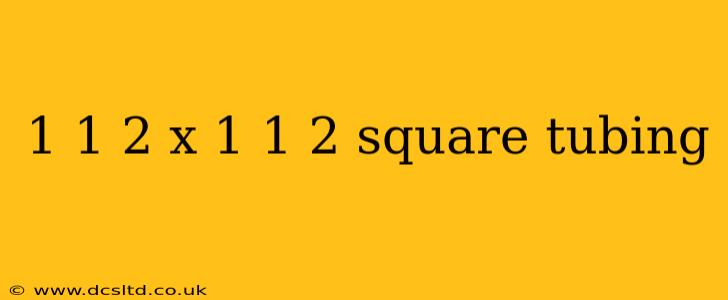Square tubing, with its robust and versatile design, is a popular choice in various industries. This post focuses specifically on 1 1/2 x 1 1/2 x 1/8 inch square tubing, delving into its dimensions, common applications, and the factors to consider when selecting the right material.
What are the dimensions of 1 1/2 x 1 1/2 x 1/8 square tubing?
The dimensions "1 1/2 x 1 1/2 x 1/8" refer to the outside dimensions of the tubing. This means:
- 1 1/2 inches: This is the width and height (or outside dimension) of each side of the square tube.
- 1/8 inch: This represents the wall thickness of the tubing. The inside dimensions would be slightly smaller, reflecting this wall thickness. Precise inside dimensions will depend on the manufacturer's tolerances.
It's crucial to understand that these are nominal dimensions. Slight variations can occur due to manufacturing processes, and confirming exact dimensions with the supplier is always recommended for precision applications.
What is 1 1/2 x 1 1/2 x 1/8 square tubing used for?
This size of square tubing finds applications in diverse fields, thanks to its balance of strength and relatively lightweight nature. Some common uses include:
- Fabrication of Structures: It's frequently used in building frameworks for smaller structures, furniture, equipment, and displays. Its square profile provides excellent stability and rigidity.
- Automotive and Motorsports: This tubing is suitable for creating custom roll cages, chassis components, and other structural elements in vehicles.
- Industrial Applications: It can be found in various industrial equipment and machinery, often forming parts of frames, supports, and enclosures.
- Agricultural Equipment: Used for constructing or reinforcing frames and components in agricultural machinery.
- Handrails and Guardrails: Its strength and clean aesthetic make it appropriate for handrails and guardrails in various settings.
What materials are commonly used for 1 1/2 x 1 1/2 x 1/8 square tubing?
The material chosen significantly impacts the tubing's properties and suitability for a specific application. Common materials include:
- Mild Steel: A cost-effective and widely available option offering good strength and weldability. It's often used for general-purpose applications where corrosion resistance is less critical.
- Aluminum: Lightweight and corrosion-resistant, aluminum square tubing is preferable in applications requiring reduced weight or exposure to the elements. It's also readily machinable.
- Stainless Steel: Offers superior corrosion resistance compared to mild steel, making it ideal for outdoor or harsh-environment applications. However, it is generally more expensive.
How do I choose the right material for my project?
The optimal material depends on several factors:
- Strength Requirements: Mild steel generally offers higher strength than aluminum. Stainless steel provides a combination of high strength and corrosion resistance.
- Weight Considerations: Aluminum is significantly lighter than steel, crucial in applications where weight is a critical factor.
- Corrosion Resistance: Stainless steel is the best choice where corrosion is a major concern, followed by aluminum.
- Budget: Mild steel is the most cost-effective, followed by aluminum and then stainless steel.
- Weldability: Mild steel is easily weldable; aluminum and stainless steel require specialized welding techniques.
Where can I buy 1 1/2 x 1 1/2 x 1/8 square tubing?
This size of square tubing is widely available from various metal suppliers, both online and in physical stores. Searching online for "1 1/2 x 1 1/2 x 1/8 square tubing" will yield numerous suppliers. Remember to specify the desired material (mild steel, aluminum, stainless steel) when ordering.
This guide provides a comprehensive overview of 1 1/2 x 1 1/2 x 1/8 square tubing. Remember to always prioritize safety when working with metal tubing and follow proper handling and safety procedures. Always consult with a qualified professional for complex structural applications.
